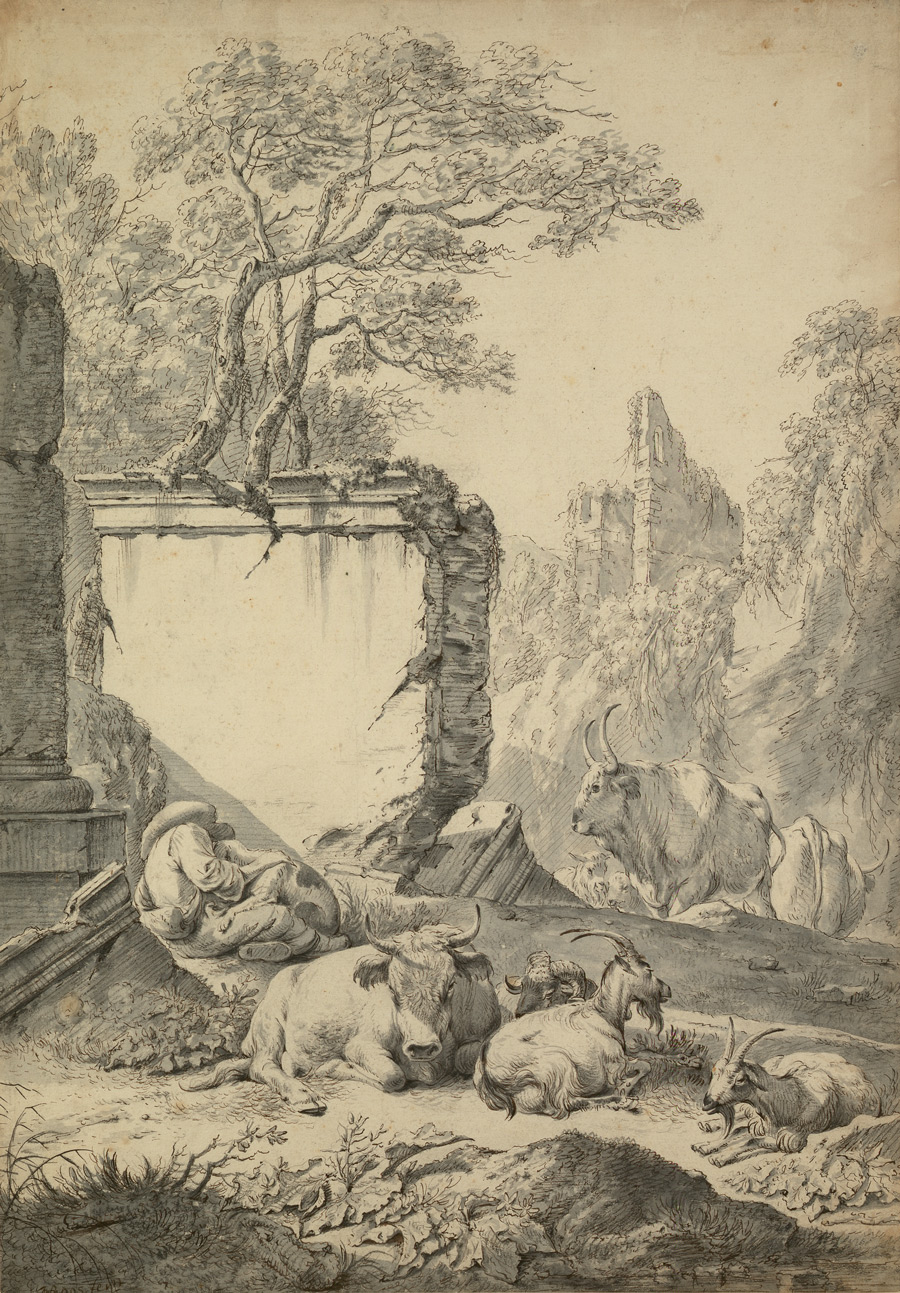Loading the page ...
Johann Heinrich Roos
(1631 Reipoltskirchen – 1685 Frankfurt am Main)
Pastoral Landscape with a Resting Herdsboy and his Flock. Pen and black and brown ink over chalk, gray wash. 47.8 x 33 cm. Signed at bottom left: JHRoos fecit. Ca. 1668/9.
This magnificent drawing shows how much Johann Heinrich Roos owed – both stylistically and iconographically – to the art of the Dutch Italianates. There is nothing surprising about this, as the Roos family had moved from the Palatinate to Amsterdam in 1640. In 1647, the young Johann Heinrich began an apprenticeship with the historical painter Guilliam Dujardin and was later trained by the landscape painter Cornelis de Bie and the animal and portrait painter Barent Graat. Some time around 1651/52 the young artist set off for Germany. There he worked mainly for noble and ecclesiastical clients in the Hesse province and married the pastor’s daughter, Anna Emmerich, in St. Goar in 1656 before moving on to Heidelberg, where he was appointed court painter in 1664. This position seems not to have lived up to his expectations, however, for in 1667 Roos settled with his family of four children in Frankfurt am Main, where he was to work with considerable success for almost twenty years.
Roos – the founder of a widely ramified dynasty of painters – was a very gifted and productive draughtsman. Most of his drawings are preliminary studies for his paintings, on which he depicted animals and herdsmen in ever changing poses. These sketches, spontaneously executed mainly with black and more rarely with red chalk, were taken directly from nature and betray a profound interest in light and atmosphere. The earliest dated drawing is from the year 1660. From the mid-1660s onwards, wash drawings in ink, which are more detailed in treatment and varied in content, become more common. The drawings in this category were probably intended for sale. They show sophisticated, fully worked out compositions featuring ruin landscapes with herdsmen and flocks and served as pendants to the paintings (see exhibition catalogue Roos. Eine deutsche Künstlerfamilie des 17. Jahrhunderts, ed. by Margarete Jarchow, Kupferstichkabinett Berlin, 1986).
The present drawing is a representative and artistically significant example of this genre. One is struck by the monumental size of the drawing, which gives it a very special position in the artist’s graphical œuvre, as Roos generally worked in smaller formats. Jedding records only a few drawings of comparable size, all of which date to around 1668/69 (Jedding 193, Stockholm, Nationalmuseum; Jedding 194–195, Vienna, Albertina, fig. 1). The drawing technique Roos uses is uncommonly refined and varied. Over a swiftly executed preliminary sketch in black chalk the details of the leaves and grasses in the foreground and the different textures of the coats, hairs and horns of the resting animals are meticulously rendered with fine, nimble pen strokes in black and brown ink. A light wash renders the play of light on their bodies in a lifelike manner.
Roos is a master of detail taken directly from life. The motif of the sleeping herdsboy, whose dog has snuggled up against him, is almost touching. A bull with imposing horns unhurriedly ascends the slightly rising path, while the bony rump of the beast on its right takes the eye downwards. The animals possess a remarkable individuality and almost resemble "character heads". The heat of noon has made both men and animals torpid; bright warm sunshine falls on the ancient fragment of wall at the left of the picture and bathes the landscape in a summer glow. In view of this perfect illusion of a pastoral Mediterranean landscape it is hard to imagine that Roos had probably never actually seen the Roman Campagna. At all events there is no evidence that the artist ever made a trip to Italy. Evidently Roos had so internalised the formal world of such Dutch Italianates as Nicolaes Berchem and Karel Dujardin that he did not miss the formative experience of a stay in Italy. Yet there is nothing epigonous about him, as he shows an extraordinarily spontaneous and lively feeling for nature in his affectionate observation of people and animals.
